Since you have to write an argumentative essay, you might as well learn how to write it well, right?
I’ve said it time and time again—there’s nothing worse than staring at a blank page. Putting together an argumentative essay outline is the perfect way to turn your blank document into a ready-to-use template. All you have to do is fill in the blanks.
In this blog post, I’m going to share with you how to create an argumentative essay outline. At the end, I’ll give you a downloadable skeleton outline you can use to get started.
Argumentative Essay Outline Structure
If you distill your argumentative essay outline down to its basics, you’ll find that it’s made of four main sections:
- Introduction
- Key arguments
- Counterargument and rebuttal
- Conclusion
That’s not so bad, is it? There’s really nothing to be afraid of.
Here’s how your argumentative essay outline would look if you turned it into a pretty picture:
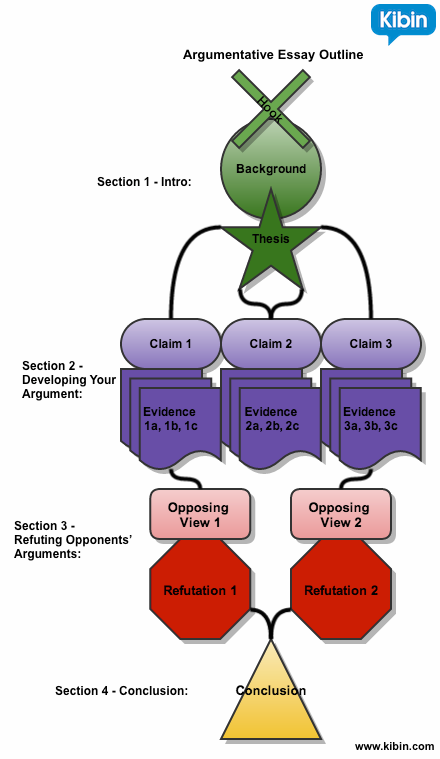
Let’s break down the four elements and take a look at what needs to be incorporated into each.
Argumentative Essay Outline Section 1: Introduction
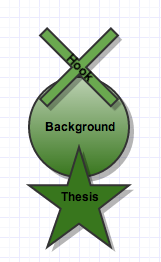
The introduction is where you lay the foundation for your impenetrable argument. It’s made up of a hook, background information, and a thesis statement.
Hook sentence
Your first sentence is comprised of a hook that grabs readers’ attention just like a good Jackie Chan movie grabs the attention of a martial arts fan. It’s a sentence that will intrigue your readers and make them want to learn more.
For instance, let’s say you’re writing an argumentative essay about why Americans should start eating insects.
The hook could be something like this:
For those interested in improving their diets and the environment, say goodbye to eating chicken, fish, and beef and hello to eating silkworms, crickets, and caterpillars.
This hook sentence grabs the attention of the audience. It also makes them want to learn more about how eating insects can improve not only their health but also the environment.
If you’re having trouble coming up with a good hook, I recommend reading these posts:
- How to Write Good Hook Sentences
- What Is a Hook Sentence? (Infographic)
- How to Write Attention Grabbers that Work
Background information
The next part of your intro is dedicated to offering some detailed background information on the topic. This will help readers understand the topic and set the stage for the focus of your paper.
Not sure what to include as background information?
Try answering the following questions:
- What is the issue at hand?
- Who cares?
- Where is this issue prevalent?
- Why is it important?
- Who does it affect?
- How long has the issue been a concern?
You might write something like this as your background information if you’re trying to convince readers that they should eat insects:
Insects are abundant, nutritious, and environmentally sustainable. Currently, people in the United States shun the idea of eating insects as part of their diets, favoring instead less nutritious and environmentally destructive food options, such as beef and pork. The UN has even issued a statement calling for more world citizens to embrace the many benefits of eating insects.
In just a few sentences, you’ve given readers a better understanding of your topic. You’ve explained that most people shun insects in favor of more traditional American meats, such as beef and pork (even though consuming these meats causes more harm to the environment).
You’ve also started to establish yourself as an authoritative and credible writer by referencing the UN, an organization that also supports the idea of including insects in a healthy diet.
Thesis statement
A thesis statement typically makes up the last sentence of your introduction paragraph and provides a roadmap to your paper. In an argumentative essay, the thesis statement should clearly state your position on the topic and give a reason for your stance.
In our essay about eating insects, the thesis statement might look like this:
A diet of insects can help fix problems related to starvation, obesity, and climate change; therefore, US citizens should learn to rely on a variety of insects over chicken, beef, and fish as their main source of protein and nutrition.
Notice the word “should” in the thesis statement? Using this word makes it clear you’re taking a stance on the argument.
You’ll also notice that this thesis statement sets up three claims to expand on later: a diet of insects can help fix problems related to starvation, obesity, and climate change.
Looking for additional help crafting the perfect thesis statement for your essay? Read these posts:
- How to Write a Thesis Statement in 5 Simple Steps
- How to Turn a Good Thesis Statement Into a Great One
If you need a few examples before you start writing your own thesis, take a look at these example argumentative thesis statements.
Once your introduction is in place, you can move on to the next section and develop the key arguments that will support your thesis statement.
Argumentative Essay Outline Section 2: Key Arguments
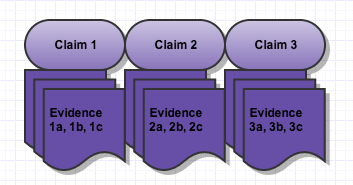
In the sample outline above, there are three claims, each backed by three points of evidence. Offering three claims is just a suggestion. You may find that you have more claims to make.
(Keep in mind that your assignment may already dictate how many claims are required for your specific paper, so make sure to read the assignment guidelines again carefully before starting.)
Developing a claim
A claim is a statement you make to support your argument. It’s generally one of the key arguments of your paper and often the topic sentence of a paragraph. (If you write a three-part thesis statement, it’s also usually one of the three points listed.)
So if you want to make a claim about eating insects, you might write something like this:
Bugs are highly nutritious, and eating them can fix the problem of hunger and malnutrition in the United States.
This claim suggests that, because bugs are nutritious, eating them can help solve hunger problems. This is a great claim, but who’s going to believe it? This is where evidence comes into play.
Supporting a claim with evidence
An argumentative essay is generally research-based, so you’ll need to include factual information from reliable sources to support your claim. The evidence you include should not be based only on personal knowledge or your own opinion.
Here’s an example you might use to support your paper about eating insects:
Research has found that “edible insects are found in a wide variety of species and are an important food item, which has a high nutritive value suitable for human nutrition. Insects are a suitable alternative food source, which can aid in the management of nutrient deficiency and overall food security if used on a wide scale” (Kinyuru et al. 18).
IMPORTANT REMINDER: If you’re using any type of evidence from sources to support claims, you must cite any information you’ve gathered from sources in an appropriate style, such as APA or MLA. (Without appropriate citation, your paper is plagiarized.)
Once you have gathered your evidence to support your claims, it’s time to add the next important elements of your argumentative essay outline: counterarguments and rebuttal.
Argumentative Essay Outline Section 3: Counterarguments and Rebuttal
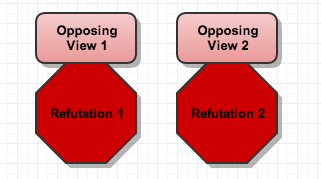
When writing an argument essay, you’re writing in support of one side of an argument. This, of course, means there’s another side, and readers might disagree with your point of view.
In order to strengthen your own argument and demonstrate that you’ve looked at all aspects of the topic, you need to address the opposing view. To do so, you need to include counterarguments and the rebuttal.
Counterarguments
In this final section of the body of your essay, you’ll first acknowledge the opposing viewpoint.
When arguing that more people in the US should start eating insects, you might address the opposing view (or counterargument) by writing something like this:
Opponents of insect eating say that, even though insects have some nutritional value, they simply don’t taste good and therefore should not be considered a food source.
This statement addresses the opposing view by acknowledging that some people don’t want to eat bugs for the simple fact that they don’t taste good. But hold up—it’s not enough to simply acknowledge the opposing view.
Rebuttal
The next step is to include the rebuttal. This is where you’ll essentially explain to your audience why your argument is valid. (You’re basically continuing to argue why you’re right.)
If you want to offer a rebuttal to the counterargument that no one wants to eat bugs because they taste awful, you might write something like this:
Even though some may cringe at the thought of eating what they feel might be disgusting bugs, insects are eaten in many parts of the world and prized for their varied tastes. Put simply, insects are “lighter than meat and heavier than seafood, [and] they’re delicious. Each one of these plant-loving insects absorbs the taste of your chosen seasoning and adds a satisfyingly crunchy texture” (Payne).
Including evidence from a credible source helps prove the opposing view is not as strong as your own argument.
Once you have refuted your opponents’ viewpoints, it’s time to sail to the finish line with your conclusion.
Argumentative Essay Outline Section 4: Conclusion
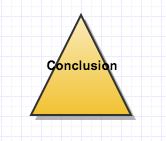 Your conclusion will accomplish two important tasks:
Your conclusion will accomplish two important tasks:
- It restates the importance of your issue.
- It paints a picture of the world if your argument is (or is not) implemented.
Restate the importance of your issue
Similar to what you did in your introduction, you want to state why this topic is critical. You can do this by restating some of the key ideas presented in your paper or by restating the ideas presented in your thesis. (Don’t use the same wording in your conclusion as you did in your introduction. Restate the ideas, not the same words.)
In the insect example, you might write something like this:
Simply by incorporating insects into their diets, US citizens can improve the sustainability and nutrition of the American diet.
Paint a picture of the world if your argument is (or is not) implemented
In the final part of the conclusion, make your audience think about the ramifications of your argument. Leave them with a powerful statement to get them thinking about your ideas.
In this example, you might want them to think about what would happen if people started eating insects as a staple of their diets. So you might write something like:
The world would be a better place if more people ate insects as a part of their diets. Fewer people would go hungry, more people would get the vitamins, minerals, and micronutrients they need to live healthy lifestyles, and the planet would be relieved of the burden of an unsustainable food system.
Closing with a clear picture of the world as you would like it to be can leave your reader convinced that your argument is valid.
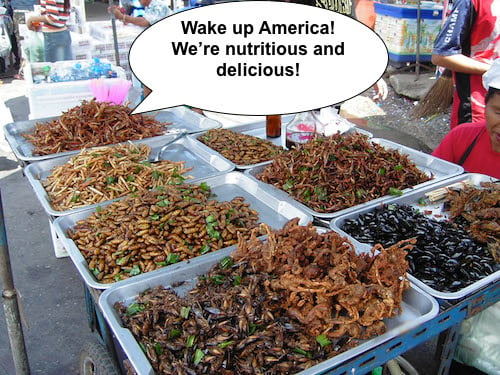
Download the Argumentative Essay Outline Template
Once you break it down, writing an argumentative essay outline isn’t that daunting.
Download this skeleton outline for an argumentative essay to get started.
Before you go off into the sunset and use this outline template, make sure that you’re following the guidelines specific to your course. If you don’t have to submit a formal outline for your class or if outlines aren’t your thing, you might also try using a graphic organizer to get your ideas on paper.
If you’re interested in learning more about argumentative essays, take a look at these posts:
- The Secrets of a Strong Argumentative Essay
- Writing an Argumentative Essay Made Easy (Infographic)
- 2 Argumentative Essay Examples With a Fighting Chance
If you’re not quite ready to write an outline and are still looking for the perfect topic for your paper, check out 70 Argumentative Essay Topics That Will Put Up a Good Fight and 30 Argumentative Essay Ideas That Will Pick a Good Fight.
Need a little more inspiration and want to see what a completed argumentative essay looks like? Check out these argumentative essay examples.
When you have your argumentative essay and outline ready to go, you can always have one of our awesome editors give it a second look.
By the way, if all this talk of eating insects has made you hungry, here are 20 bug recipes you might want to try.
Good luck with your essay, and happy dining!
Editor’s note: This post was originally published on July 7, 2014, but has been updated with fresh information and advice.
